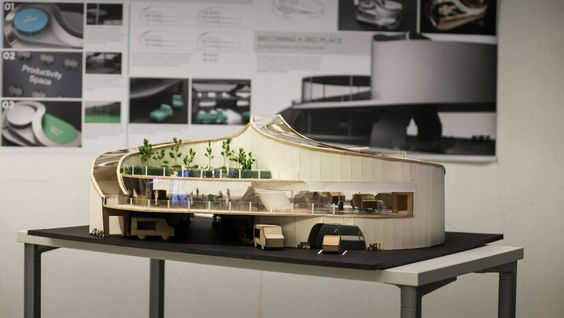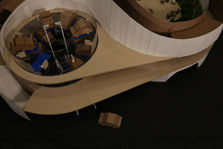

the future of urban mobility
COMMUNITY CHARGE
THE OPPURTUNITY
The rise of multi-modal mobility and expectations of new shared space models creates an interesting opportunity for charging stations. How can we streamline and rethink the charging space itself for both vehicles and guests. How can we reframe this from time lost, to time gained?”
THE PROMPT
“While charging stations have evolved to answer to new car innovations,
the experience of the physical space itself has not yet evolved to suit
the needs of guests. How can you use this opportunity to streamline and rethink the charging space itself for both vehicles and guests."
ROLE
Experience Designer, Model Making, User Research, Project Lead
Group Members:
TIMELINE
Fall 2023 - 12 Week Project
2023 International Design Exellence Awards Finalist
AWARDS

As a team we conducted research about urban transportation and the daily workflows of people. This allowed us to create personas and begin finding pain points within the users journeys.
.01 Framing the Problem

Personas



Sporadic Sally
Not bogged down with payments; likes to exercise. Her needs change by the month. Uses her parents Personal Electric Vehicle (PEV)
Working Will
Will is a corporate man with a love for fancy cars and being at the forefront of new technology.
Owns a PEV.
Cautious Casey
Plans work needs & family trips carefully and can get held up by new technology. Owns a PEV.

Key Insights
ownership
Individuals looking to own electric vehicles place value on the brand, but are prone to abandonment after a few years due to range and even power outages. Communal experiences feel disconnected between fuel pumps and convenience stores, or isolated public chargers.
Commonly, EV owners sit in their unpowered car on their phone while charging in public, itching to connect with their community meaningfully. Spending hours exploring a town takes time but worth it when the opportunity arises.
efficiency
preparation
EV owners buy the car first then figure out charging later, which re-implements the gas station experience they hoped to escape, often making the situation even more stressful. They install chargers at home, make do with a few public charging methods, and Tesla owners learned to carry an adapter with them.
availability
Sharing chargers at home, supercharger difficulties, and loyalty to public chargers are among a list of availability complications. Scooters are encountered by chance, and American public transport is typically underutilized.
Lacking connection to community in transportation
Difficulty finding transport and spending that time well

With our key insights and design opportunity narrowed down, we began to go through an iterative process of figuring out our concepts. We focused a lot on form and how our charging station could fit into a community. Through this process we explored many different ways to
give purpose to lost space in cities (Church parking lots during the
week, abandoned areas, above gas stations)
.02 developing concepts






.03 testing

3 Testing Points
.01 Parking Flow
We made a low fidelity prototype to begin to see how people naturally interacted with the space and what assumptions were made. We used this to guide placement of parking and fill the space with purpose.
To ensure freedom of placement, participants were only informed of the orientation of the car and that they were parking at a building they would spend a few hours at.





few parked here
popular parking
unintended
parking
The unintended parking led to a breakthrough in our design: adding a car elevator. We developed this idea further and began testing it.

.02 Charging Process
With our parking further developed, we wanted to test and resolve pain points in the elevator parking process and charger preparation.
We had people park their car in a designated parking spot, navigate through our car elevator system and interact with the Charger Kiosk UI.
Findings:
-
More safety measures for ensuring users distance from vehicle
-
Clearer parking area navigation needed
-
Charger Kiosk UI: a “step by step” process that will guide first time users through the process in using the elevator
-
How to ensure trust between humans and the car elevator



.03 Amenity Testing
I put together a survey and sent it out to find out what amenities would best serve the community within this space.
The results showed that there is a dichotomy of desires vs. availability.
People struggle to make the code switch in order to leave home and travel to a third place. This lead us to a strong pitch angle for Community Charge.

COMMUNITY CHARGE MODEL & renders
yOU MAY ALSO LIKE . . .

























.jpg)
